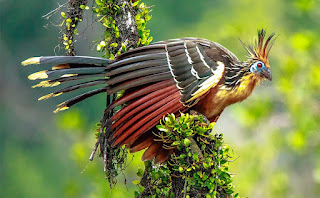
Hoatzin is a turkey-like fowl that can’t be effectively grouped because of numerous particular highlights. Hoatzin seems as though a flying creature identified with cuckoos, fowls and old ancient winged animals, yet toward the end it actually has one of a kind attributes which are the motivation behind why it is allotted to a different family called Opisthocomidae. Hoatzin can be discovered uniquely in South America, going from Guyana and Ecuador, to Brazil, Bolivia and Orinoco, close to the oxbow lakes in the Amazon wilderness.
They are the only bird which eats leaves as a main part of their diet. Their gut has special adaptations which help their digestion.
Hoatzin can reach 25 inches in length and 1.78 pounds of weight.
The hoatzin is also notable for having young with claws on two of their wing digits.
Hoatzin has a long neck, small head with reddish-brown crest, and blue facial skin with red eyes. Its body is covered with dark and light brown feathers combined with white and yellow feathers.
They are the only living member of the family Opisthocomidae. Its close relatives probably died out long ago. There has been much debate about the hoatzin’s relationships with other birds.
Hoatzin has a long tail composed of ten, loosely attached feathers.
Hoatzins use bacterial fermentation in the front part of the gut to break down the vegetable material, much as cattle and other ruminants do.
Hoatzin is a clumsy bird. It spends most of the time near the water and on the branches of the surrounding trees.
Although hoatzin has completely developed wings, it rarely flies. Unlike other flying birds, its pectoral muscles (muscles on the chest) are poorly developed. One of the reasons is that its crop (part of the digestive system) is overly developed and takes more place than in other birds.
The crop of the hoatzin is so large that it displace the flight muscles and keel of the sternum.
Hoatzins are one of the rare birds that are exclusively herbivores. They eat different kind of green plants such as leaves of arum, legume trees and other succulent plants. Hoatzin spends 4 hours a day in eating. It eats in the early morning and late evening hours.
Hoatzins are seasonal breeders, breeding during the rainy season, the exact timing of which varies across its range.
Due to specific type of diet, hoatzin digests its food with a help of bacteria in its crop. Similar process takes place in the stomach of the ruminants.
Hoatzins are gregarious and nest in small colonies, laying two or three eggs in a stick nest in a tree hanging over water in seasonally flooded forests.
Food fermentation produces unique and unpleasant smell (a manure-like smell), which is why hoatzin is also known as “stinkbird” or “stinking pheasant”. Amazonian people avoid hunting and eating hoatzin because of its smell.
The chicks, which are fed on regurgitated fermented food, have another odd feature; they have two claws on each wing. Immediately on hatching, they can use these claws, and their oversized feet, to scramble around the tree branches without falling into the water.
Unique feature, characteristic for both the hoatzin and the prehistoric dinosaur called Archaeopteryx (which was a blend between lizards and birds) are claws at the end of wings. Hoatzin uses its claws to climb the trees. Further examination showed that hoatzin is not a modern version of the Archaeopteryx; it developed claws because of the specific life style. Claws prevent hoatzin to fall into the water while climbing the nearby vegetation.
When predators such as the great black hawk attack a hoatzin nesting colony, the adults fly noisily about, trying to divert the predator’s attention, while the chicks move away from the nest and hide among the thickets.
Hawks and other large birds hunt hoatzin. They are especially interested in the young animals, which are located in the nests on the trees above the water. If the young hoatzin falls from the nest, it will swim until it reaches the safety of the ground and the tree (and escape the predators).
Hoatzins live in groups (colonies) composed of 10 to 50 birds.
Mating season takes place during tropical rainy season. Males and females build nests together using the branches and sticks. Nests are usually 5 to 21 feet long, located on the trees.
Female lays between two and five eggs. They are yellowish to creamy white in color and have blue or violet spots.
All birds in the colony participate in the rising of the young birds.
Average lifespan of the hoatzin is 15 years in the wild and up to 30 years in captivity.
Hoatzin FAQs: Unveiling the Secrets of the “Stinkbird”
The hoatzin, a peculiar bird native to South America, has captivated biologists for centuries with its unusual features and behaviors. Here’s a dive into some frequently asked questions about this fascinating creature:
1. What exactly is a hoatzin?
The hoatzin (Opisthocomus hoazin) is a pheasant-sized bird found in the swamps, forests, and freshwater mangroves of the Amazon and Orinoco river basins. It has a long neck, small head, and spiky crest, often sporting a messy-looking appearance. Despite its superficial resemblance to chickens and other landfowl, the hoatzin occupies a unique evolutionary niche.
2. What makes the hoatzin so strange?
The hoatzin boasts a number of unusual characteristics:
- Fermenting Foodie: Unlike most birds, hoatzins are primarily herbivores, feeding almost exclusively on leaves. Their digestive system functions similarly to a cow’s, with a large crop that utilizes bacterial fermentation to break down tough leaves. This process allows them to extract nutrients from their leafy diet but also gives them a rather unpleasant odor, earning them the nickname “stinkbird.”
- Winged Whelps: Hoatzin chicks hatch with two sharp claws on each wing, a trait reminiscent of dinosaur fossils like Archaeopteryx. These claws help them climb around branches in the nest, allowing them to escape predators by dropping into the water below and swimming to safety. They lose these claws after about three months.
- Cooperative Clan: Hoatzins are social birds, living in family groups or small flocks. Both parents, along with older siblings, participate in raising the young, a behavior uncommon among most bird species.
3. Are hoatzins related to anything else?
The hoatzin’s evolutionary lineage is a bit of a puzzle. While some features suggest a connection to ground birds like chickens and guineafowl, others point towards a more distant relationship with cuckoos and turacos. Scientists are still unraveling the hoatzin’s family tree.
4. Are hoatzins endangered?
The hoatzin is currently classified as “Least Concern” by the IUCN. However, habitat loss due to deforestation and the damming of rivers pose potential threats to their populations. Conservation efforts are focused on protecting their wetland habitats and raising awareness about this unique bird.
5. Can I see a hoatzin in a zoo?
While not as common as pigeons or parrots, hoatzins can be found in some zoos and bird sanctuaries around the world. If you’re interested in seeing one for yourself, check the websites of zoos near you to see if they house these fascinating creatures.
6. What sounds do hoatzins make?
Hoatzins are known for their loud, raucous calls, often described as a combination of grunts, hisses, and croaks. They use these vocalizations to communicate with each other, particularly during breeding season and territorial disputes.
7. Do hoatzins smell bad all the time?
The strong odor associated with hoatzins comes from the fermentation process in their crops. The smell is most noticeable when they are close by or when they feel threatened. Generally, the odor isn’t overpowering from a distance.
8. Are hoatzins considered intelligent birds?
While not known for mimicking human speech or performing complex tricks, hoatzins exhibit some signs of intelligence. Their cooperative breeding behavior and ability to utilize tools (their wing claws) suggest a degree of cognitive ability. More research is needed to fully understand their intelligence.
The hoatzin, with its bizarre blend of features and behaviors, is a testament to the diversity of life on Earth. Hopefully, these FAQs have sparked your curiosity about this one-of-a-kind bird!








